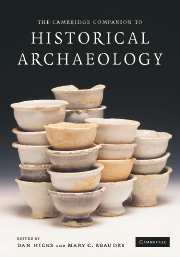Book contents
- Frontmatter
- Dedication
- Contents
- List of figures
- List of tables
- List of contributors
- Acknowledgements
- List of abbreviations
- 1 Introduction: the place of historical archaeology
- PART I ARCHAEOLOGY AND HISTORY
- PART II KEY THEMES IN HISTORICAL ARCHAEOLOGY
- PART III HISTORICAL ARCHAEOLOGY AND MATERIAL CULTURE
- PART IV HISTORICAL ARCHAEOLOGY AND LANDSCAPES
- PART V HISTORICAL ARCHAEOLOGY AND BUILDINGS
- 15 Historical archaeology and buildings
- 16 Household archaeology, identities and biographies
- 17 Afterword: historical archaeology in the wider discipline
- References
- Index
16 - Household archaeology, identities and biographies
from PART V - HISTORICAL ARCHAEOLOGY AND BUILDINGS
Published online by Cambridge University Press: 05 July 2015
- Frontmatter
- Dedication
- Contents
- List of figures
- List of tables
- List of contributors
- Acknowledgements
- List of abbreviations
- 1 Introduction: the place of historical archaeology
- PART I ARCHAEOLOGY AND HISTORY
- PART II KEY THEMES IN HISTORICAL ARCHAEOLOGY
- PART III HISTORICAL ARCHAEOLOGY AND MATERIAL CULTURE
- PART IV HISTORICAL ARCHAEOLOGY AND LANDSCAPES
- PART V HISTORICAL ARCHAEOLOGY AND BUILDINGS
- 15 Historical archaeology and buildings
- 16 Household archaeology, identities and biographies
- 17 Afterword: historical archaeology in the wider discipline
- References
- Index
Summary
Sometime in the late 1670s, Charles Calvert, the third Lord Baltimore and proprietor of the Maryland colony in North America, made the decision to erect the colony's magazine adjacent to his family's plantation dwelling at Mattapany in Maryland. Clearly, Calvert was making a social and political statement about his power as proprietor, setting the magazine on the public approach to his large brick and timber house. But this decision also suggests Calvert's growing anxiety about the political state of affairs in his colony. Along with members of his council, Calvert worried about the pirates who, he was certain, plied the waters of the nearby Patuxent River, and in 1675 he was particularly shaken when a large number of Susquehannock leaders unexpectedly arrived at Mattapany. More mundane but no less a problem was Calvert's relationship with his colony's denizens, many of whom were growing to resent the proprietor's extraordinary legal and political power. Indeed, Calvert may have at this time erected a substantial log palisade around his dwelling in an effort to provide his family an additional measure of protection from these and other political uncertainties (Chaney 1999).
Across the river from Mattapany at a much smaller plantation known today as Patuxent Point, an unidentified English family and their servants were living in a modest ‘earthfast’ timber domestic structure. No palisade or paling fence enclosed the dwelling yard and, from all appearances, a visitor could just walk up to the dwelling's principal door. Archaeological evidence suggests that the site's occupants were perhaps not as concerned about pirates or unwelcome Indians as were Calvert and his council. Indeed, comparatively large numbers of Indian-made earthenware tobacco pipes from this site suggest interactions with local native people were frequent and perhaps friendlier than those taking place at Mattapany. Still, two archaeological features suggest that the Patuxent Point site's occupants were also preoccupied with a need for protection. A small pit outside one of the dwelling's doorways contained four inverted case bottles which, although now broken, had been placed in the ground intact. Associated fragments of corroded nails suggest that these bottles were part of a ritual intended to counter a witch's spell.
- Type
- Chapter
- Information
- The Cambridge Companion to Historical Archaeology , pp. 293 - 313Publisher: Cambridge University PressPrint publication year: 2006
- 23
- Cited by



